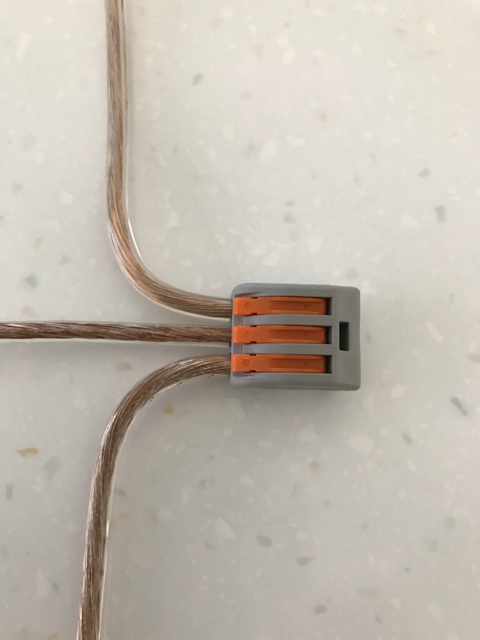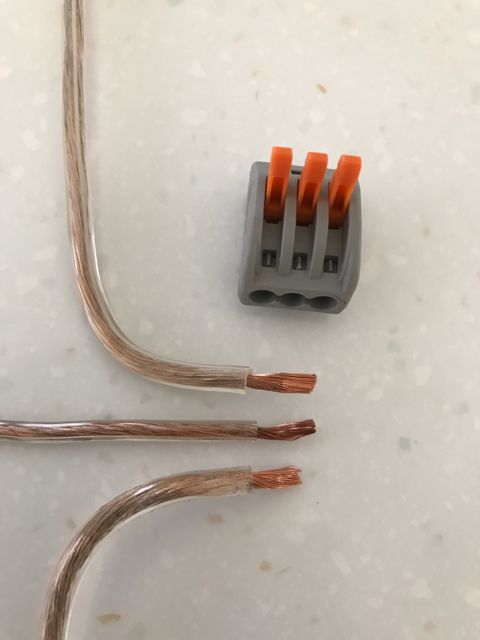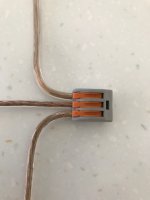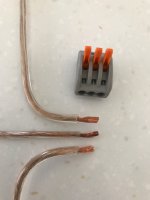I ran 2 (bigger) wires trough the enclosure and branched from that every 5 drivers. It's following the same schematic you show.
I ran 2 (bigger) wires trough the enclosure and branched from that every 5 drivers. It's following the same schematic you show.
How did you branch it out? Just solder?
Yes, open up the mantle so a piece of bare wire is visible, pry a gap in that wire (multi strand wire) to lock the branch into, twist them firmly together for a lot of physical contact and solder to seal it. A piece of shrink tubing over it to finish it off.
It seems the industry is catching on, lately more and more speakers are using a form of DSP to get listeners closer to the music. We had Kii as a good example, the enormous effort from B&O, Lexicon coming with a new proposal and even Dynaudio, a well established name is moving in that direction.
Here's a nicely written and well thought out review by Mitch over on Computer Audiophile:
Dynaudio Focus 600 XD Loudspeaker Review
I do consider it an honour to be mentioned in the article (now you know why I posted that new room picture 😉).
Here's a nicely written and well thought out review by Mitch over on Computer Audiophile:
Dynaudio Focus 600 XD Loudspeaker Review
I do consider it an honour to be mentioned in the article (now you know why I posted that new room picture 😉).
I have made a lot of those joints in the past but recently I have been using these lever clamps for joining mains AC and transformer windings.
This is what I planned to do. They clamp down very tight and it would take a significant amount of force to pull them out. The wire in the middle is the branch that will go to the driver the others go up and down the cabinet. The plastic part is then stuck to the cabinet with hot glue or strong double sided tape.

This is what the components look like

By doing it this way I can still access the wiring through the driver holes if there is an issue. If need be all the wiring could be replaced from outside the cabinet as I won't have any removable panels.
I have been looking at car damping sheets like the silent coat you mentioned but the price is quite significant to cover the entire enclosure. I think I will make a test piece with some of the rubber I have to see what difference it makes to MDF when glued to it.
This is what I planned to do. They clamp down very tight and it would take a significant amount of force to pull them out. The wire in the middle is the branch that will go to the driver the others go up and down the cabinet. The plastic part is then stuck to the cabinet with hot glue or strong double sided tape.
This is what the components look like
By doing it this way I can still access the wiring through the driver holes if there is an issue. If need be all the wiring could be replaced from outside the cabinet as I won't have any removable panels.
I have been looking at car damping sheets like the silent coat you mentioned but the price is quite significant to cover the entire enclosure. I think I will make a test piece with some of the rubber I have to see what difference it makes to MDF when glued to it.
Attachments
I can open up my entire enclosure in case of trouble. I wanted to build a serviceable speaker which is why I did what I did. We all have our own view on things, nothing wrong with that!
The CLD panels might even be useless in out wood enclosures, as they were meant to dampen thin sheet metal. You'd only need to cover about a quarter for good results. I did use it in strategic places, as you may remember, I cut my enclosures in 25 parts. Sealed up the outer perimeters with epoxy and fiberglass matt, in the cut itself a foam was used, inside it was 'lined' with a rubber flexible glue, and that's where I applied the CLD (plus on my thinner braces). Overkill? Probably... Piece of mind? Yes... 🙂
As two grown men who were hugging my speakers upon their visit can testify to, it did work to keep the enclosure dead. Even with the ear on the side. It's about the only thing in the room that doesn't move along to the music.
I have been looking at car damping sheets like the silent coat you mentioned but the price is quite significant to cover the entire enclosure. I think I will make a test piece with some of the rubber I have to see what difference it makes to MDF when glued to it.
The CLD panels might even be useless in out wood enclosures, as they were meant to dampen thin sheet metal. You'd only need to cover about a quarter for good results. I did use it in strategic places, as you may remember, I cut my enclosures in 25 parts. Sealed up the outer perimeters with epoxy and fiberglass matt, in the cut itself a foam was used, inside it was 'lined' with a rubber flexible glue, and that's where I applied the CLD (plus on my thinner braces). Overkill? Probably... Piece of mind? Yes... 🙂
As two grown men who were hugging my speakers upon their visit can testify to, it did work to keep the enclosure dead. Even with the ear on the side. It's about the only thing in the room that doesn't move along to the music.
Build question:
What size are you making the cutouts? I do mine with the 3" hole saw, and it's just a hair too tight. I haven't found a hole saw in inch size that is right.
What size are you making the cutouts? I do mine with the 3" hole saw, and it's just a hair too tight. I haven't found a hole saw in inch size that is right.
Build question:
What size are you making the cutouts? I do mine with the 3" hole saw, and it's just a hair too tight. I haven't found a hole saw in inch size that is right.
Mine were 77.5mm and the driver just sneaks through. The closest imperial size is 3 + 1/16 (77.8mm) which is the figure Roger Russell quoted in his article. The smaller Jasper circle jig would cut them or you can get an adjustable holesaw from amazon or ebay.
I can open up my entire enclosure in case of trouble. I wanted to build a serviceable speaker which is why I did what I did. We all have our own view on things, nothing wrong with that!
I really like the way you built yours and the aluminium makes a really good mounting surface. I have thought long and hard about trying to make one of the panels removable but I think it will just compromise the structure and make a leak more likely unless I use an awful lot of fasteners. MDF is also much better glued, it will take fasteners but without glue as well they tend to fail.
The CLD panels might even be useless in out wood enclosures, as they were meant to dampen thin sheet metal. You'd only need to cover about a quarter for good results. I did use it in strategic places, as you may remember, I cut my enclosures in 25 parts. Sealed up the outer perimeters with epoxy and fiberglass matt, in the cut itself a foam was used, inside it was 'lined' with a rubber flexible glue, and that's where I applied the CLD (plus on my thinner braces). Overkill? Probably... Piece of mind? Yes... 🙂
As two grown men who were hugging my speakers upon their visit can testify to, it did work to keep the enclosure dead. Even with the ear on the side. It's about the only thing in the room that doesn't move along to the music.
If there is a simple and fairly cheap way to get the cabinet more inert then I think I will try it. Maybe putting some rubber or damping on the thinner braces and on the larger parts of the panel might be the best option.
It seems the industry is catching on, lately more and more speakers are using a form of DSP to get listeners closer to the music. We had Kii as a good example, the enormous effort from B&O, Lexicon coming with a new proposal and even Dynaudio, a well established name is moving in that direction.
Here's a nicely written and well thought out review by Mitch over on Computer Audiophile:
Dynaudio Focus 600 XD Loudspeaker Review
I do consider it an honour to be mentioned in the article (now you know why I posted that new room picture 😉).
Agree its nicely written in it was a pleasure to read so documented review in regards both subjective and objective explanations, with all the good documentation and links gathered there in one point think its very good use as reference work point how to get better acoustics, so have to say thanks share and taking time mitchba and wesayso.
Thanks, good to know. The nearest I can find is 3-1/8th inch, which is 79.4mm. That's bigger than it needs to be. Been looking for a 78mm saw on French websites, but no luck so far.Mine were 77.5mm and the driver just sneaks through.
Thanks, good to know. The nearest I can find is 3-1/8th inch, which is 79.4mm. That's bigger than it needs to be. Been looking for a 78mm saw on French websites, but no luck so far.
Here's one and those TCT bits are really good.
ProFit carbide tipped hole saw 3 1/16 inch (77 mm)
They only have 76 and 79mm in that document though
Last edited:
Thanks!  The 79 might be the one I want. 78 would be ideal, but they don't seem to exist. That 77mm looks good, but they do want some $$ for it.
The 79 might be the one I want. 78 would be ideal, but they don't seem to exist. That 77mm looks good, but they do want some $$ for it.
 The 79 might be the one I want. 78 would be ideal, but they don't seem to exist. That 77mm looks good, but they do want some $$ for it.
The 79 might be the one I want. 78 would be ideal, but they don't seem to exist. That 77mm looks good, but they do want some $$ for it.Thanks!The 79 might be the one I want. 78 would be ideal, but they don't seem to exist. That 77mm looks good, but they do want some $$ for it.
This link lists one as both 3 1/16 and 78mm so the sizing may not be exact. I think 78mm is the size for cutting holes for halogen downlights so the tool might be marketed for that appliction.
https://www.ccw-tools.com/Presto-9S700---Bi-Metal-Hole-Saw---78mm__p-30518.aspx
I find most holesaw's cut slightly larger than stated unless you have a very good drill press as they tend to wobble a little which makes the hole bigger.
If you are building one of these you will be making a lot of holes so getting a decent tool will be worth the money. The TCT ones cut much easier and leave a better finish. A little bit of money vs time and frustration, that's why I got mine cut by CNC in the end I could make everything exactly the size I wanted 😉
Laser cutting is less expensive than CNC if all you want is the holes cut straight through. Could be hardly anymore than buying a decent holesaw if you can find someone local to you. The edges get burnt but in this application it won't be visible.
Last edited:
This is not mine, pulled from a Norwegian audio fora.
Open baffle curved array with sealed 12" sub as base. Active crossover, 6 channels IIRC.
Full link to thread, some pictures which need no translation:
Open baffle "Krum-kast"
🙂
Open baffle curved array with sealed 12" sub as base. Active crossover, 6 channels IIRC.
Full link to thread, some pictures which need no translation:
Open baffle "Krum-kast"
🙂
Attachments
This is not mine, pulled from a Norwegian audio fora.
Open baffle curved array with sealed 12" sub as base. Active crossover, 6 channels IIRC.
🙂
Holy cow! There's always means to get things even more complicated 😀
If I only had more room in my appartment... 😱
That's a daring move putting the drivers side by side...
This was exactly my first thought when seeing the picture 😉
- Home
- Loudspeakers
- Full Range
- The making of: The Two Towers (a 25 driver Full Range line array)


